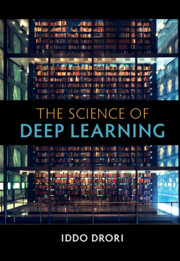Refine search
Actions for selected content:
6791 results in Communications and signal processing
10 - Variational Inference and Variational Expectation Maximization
- from Part III - Advanced Tools and Algorithms
-
- Book:
- Machine Learning for Engineers
- Published online:
- 25 January 2023
- Print publication:
- 03 November 2022, pp 368-418
-
- Chapter
- Export citation
9 - Exponential Family of Distributions
- from Part III - Advanced Tools and Algorithms
-
- Book:
- Machine Learning for Engineers
- Published online:
- 25 January 2023
- Print publication:
- 03 November 2022, pp 332-367
-
- Chapter
- Export citation
14 - Federated Learning
- from Part IV - Beyond Centralized Single-Task Learning
-
- Book:
- Machine Learning for Engineers
- Published online:
- 25 January 2023
- Print publication:
- 03 November 2022, pp 541-562
-
- Chapter
- Export citation
Part II - Fundamental Concepts and Algorithms
-
- Book:
- Machine Learning for Engineers
- Published online:
- 25 January 2023
- Print publication:
- 03 November 2022, pp 51-308
-
- Chapter
- Export citation

GNSS Software Receivers
-
- Published online:
- 28 October 2022
- Print publication:
- 17 November 2022

The Science of Deep Learning
-
- Published online:
- 23 September 2022
- Print publication:
- 18 August 2022
-
- Textbook
- Export citation
Part III - Generative Models
-
- Book:
- The Science of Deep Learning
- Published online:
- 23 September 2022
- Print publication:
- 18 August 2022, pp 151-152
-
- Chapter
- Export citation
Matrix Calculus
-
- Book:
- The Science of Deep Learning
- Published online:
- 23 September 2022
- Print publication:
- 18 August 2022, pp 293-295
-
- Chapter
- Export citation
Preface
-
- Book:
- The Science of Deep Learning
- Published online:
- 23 September 2022
- Print publication:
- 18 August 2022, pp xv-xvi
-
- Chapter
- Export citation
Figures
-
- Book:
- Quantum Information and Quantum Optics with Superconducting Circuits
- Published online:
- 04 August 2022
- Print publication:
- 18 August 2022, pp xi-xii
-
- Chapter
- Export citation
Appendix A - Hamiltonian Diagonalizations
-
- Book:
- Quantum Information and Quantum Optics with Superconducting Circuits
- Published online:
- 04 August 2022
- Print publication:
- 18 August 2022, pp 270-276
-
- Chapter
- Export citation
Part IV - Reinforcement Learning
-
- Book:
- The Science of Deep Learning
- Published online:
- 23 September 2022
- Print publication:
- 18 August 2022, pp 191-192
-
- Chapter
- Export citation
3 - Optimization
- from Part I - Foundations
-
- Book:
- The Science of Deep Learning
- Published online:
- 23 September 2022
- Print publication:
- 18 August 2022, pp 35-55
-
- Chapter
- Export citation
Contents
-
- Book:
- The Science of Deep Learning
- Published online:
- 23 September 2022
- Print publication:
- 18 August 2022, pp v-xiv
-
- Chapter
- Export citation
12 - Deep Reinforcement Learning
- from Part IV - Reinforcement Learning
-
- Book:
- The Science of Deep Learning
- Published online:
- 23 September 2022
- Print publication:
- 18 August 2022, pp 229-250
-
- Chapter
- Export citation
1 - Introduction
- from Part I - Foundations
-
- Book:
- The Science of Deep Learning
- Published online:
- 23 September 2022
- Print publication:
- 18 August 2022, pp 3-8
-
- Chapter
- Export citation
6 - Superconducting Qubits
-
- Book:
- Quantum Information and Quantum Optics with Superconducting Circuits
- Published online:
- 04 August 2022
- Print publication:
- 18 August 2022, pp 106-155
-
- Chapter
- Export citation
Part I - Foundations
-
- Book:
- The Science of Deep Learning
- Published online:
- 23 September 2022
- Print publication:
- 18 August 2022, pp 1-2
-
- Chapter
- Export citation
7 - Qubit–Photon Interaction
-
- Book:
- Quantum Information and Quantum Optics with Superconducting Circuits
- Published online:
- 04 August 2022
- Print publication:
- 18 August 2022, pp 156-197
-
- Chapter
- Export citation
7 - Graph Neural Networks
- from Part II - Architectures
-
- Book:
- The Science of Deep Learning
- Published online:
- 23 September 2022
- Print publication:
- 18 August 2022, pp 124-141
-
- Chapter
- Export citation
